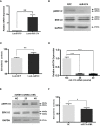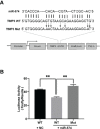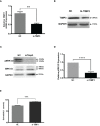MicroRNA-574 Impacts Granulosa Cell Estradiol Production via Targeting TIMP3 and ERK1/2 Signaling Pathway
- PMID: 35813635
- PMCID: PMC9261285
- DOI: 10.3389/fendo.2022.852127
MicroRNA-574 Impacts Granulosa Cell Estradiol Production via Targeting TIMP3 and ERK1/2 Signaling Pathway
Abstract
Estradiol represents a key steroid ovarian hormone that not only plays a vital role in ovarian follicular development but also is associated with many other reproductive functions. Our primary study revealed that miR-574 expression decreased in porcine granulosa cells during development from small to large follicles, and the increase of ERK1/2 phosphorylation accompanies this change. Since it has been well established that the ERK1/2 activity is tightly associated with granulosa cell functions, including ovarian hormone production, we thus further investigate if the miRNA is involved in the regulation of estradiol production in granulosa cells. We found that overexpression of miR-574 decreased phosphorylated ERK1/2 without affecting the level of ERK1/2 protein, and on the other hand, the inhibition of miR-574 increased phosphorylated ERK1/2 level (P<0.05); meanwhile, overexpression of miR-574 increased estradiol production but knockdown of miR-574 decreased estradiol level in granulosa cells. To further identify the potential mechanism involved in the miR-574 regulatory effect, in silico screening was performed and revealed a potential binding site on the 3'UTR region of the tissue inhibitor of metalloproteinase 3 (TIMP3). Our gain-, loss- of function experiments, and luciferase reporter assay confirmed that TIMP3 is indeed the target of miR-574 in granulosa cell. Furthermore, the siRNA TIMP3 knockdown resulted in decreased phosphorylated ERK1/2, and an increase in estradiol production. In contrast, the addition of recombinant TIMP3 increased phosphorylated ERK1/2 level and decreased estradiol production. In summary, our results suggest that the miR-574-TIMP3-pERK1/2 cascade may be one of the pathways by which microRNAs regulate granulosa cell estradiol production.
Keywords: ERK1/2 phosphorylation; Estradiol; Granulosa cell; Ovary; TIMP3; miR-574; microRNA.
Copyright © 2022 Pan, Zhan and Li.
Conflict of interest statement
The authors declare that the research was conducted in the absence of any commercial or financial relationships that could be construed as a potential conflict of interest.
Figures







Similar articles
-
MicroRNA-21 enhances estradiol production by inhibiting WT1 expression in granulosa cells.J Mol Endocrinol. 2021 Nov 12;68(1):11-22. doi: 10.1530/JME-21-0162. J Mol Endocrinol. 2021. PMID: 34665763
-
MicroRNA-21 up-regulates metalloprotease by down-regulating TIMP3 during cumulus cell-oocyte complex in vitro maturation.Mol Cell Endocrinol. 2018 Dec 5;477:29-38. doi: 10.1016/j.mce.2018.05.011. Epub 2018 May 15. Mol Cell Endocrinol. 2018. PMID: 29775626
-
MiRNA-143 mediates the proliferative signaling pathway of FSH and regulates estradiol production.J Endocrinol. 2017 Jul;234(1):1-14. doi: 10.1530/JOE-16-0488. J Endocrinol. 2017. PMID: 28649090
-
Expression and regulative function of tissue inhibitor of metalloproteinase 3 in the goat ovary and its role in cultured granulosa cells.Mol Cell Endocrinol. 2015 Sep 5;412:104-15. doi: 10.1016/j.mce.2015.06.001. Epub 2015 Jun 5. Mol Cell Endocrinol. 2015. PMID: 26054746
-
Tissue Inhibitor of Metalloproteinase 3: Unravelling Its Biological Function and Significance in Oncology.Int J Mol Sci. 2024 Mar 10;25(6):3191. doi: 10.3390/ijms25063191. Int J Mol Sci. 2024. PMID: 38542164 Free PMC article. Review.
Cited by
-
Granulosa Cells-Related MicroRNAs in Ovarian Diseases: Mechanism, Facts and Perspectives.Reprod Sci. 2024 Dec;31(12):3635-3650. doi: 10.1007/s43032-024-01523-w. Epub 2024 Apr 9. Reprod Sci. 2024. PMID: 38594585 Review.
-
MiR-202-5p Regulates Geese Follicular Selection by Targeting BTBD10 to Regulate Granulosa Cell Proliferation and Apoptosis.Int J Mol Sci. 2023 Apr 5;24(7):6792. doi: 10.3390/ijms24076792. Int J Mol Sci. 2023. PMID: 37047763 Free PMC article.
-
The roles of MAPK signaling pathway in ovarian folliculogenesis.J Ovarian Res. 2025 Jul 14;18(1):152. doi: 10.1186/s13048-025-01737-9. J Ovarian Res. 2025. PMID: 40660328 Free PMC article. Review.
-
Dynamic Expression of Follicle-Stimulating Hormone and Estrogen mRNA Receptors Associated with microRNAs 34a and -let-7c in Canine Follicles during the Estrous Cycle.Animals (Basel). 2024 Jan 9;14(2):214. doi: 10.3390/ani14020214. Animals (Basel). 2024. PMID: 38254383 Free PMC article.
-
miR-202-5p Inhibits Lipid Metabolism and Steroidogenesis of Goose Hierarchical Granulosa Cells by Targeting ACSL3.Animals (Basel). 2023 Jan 17;13(3):325. doi: 10.3390/ani13030325. Animals (Basel). 2023. PMID: 36766213 Free PMC article.
References
Publication types
MeSH terms
Substances
LinkOut - more resources
Full Text Sources
Research Materials
Miscellaneous

